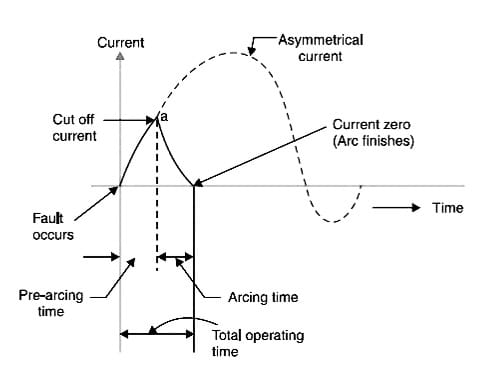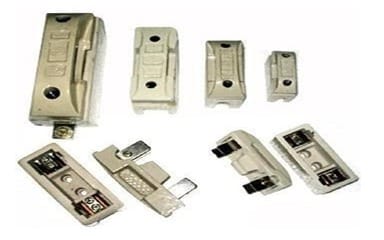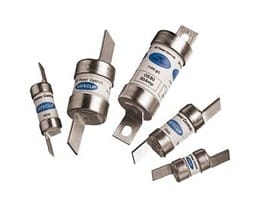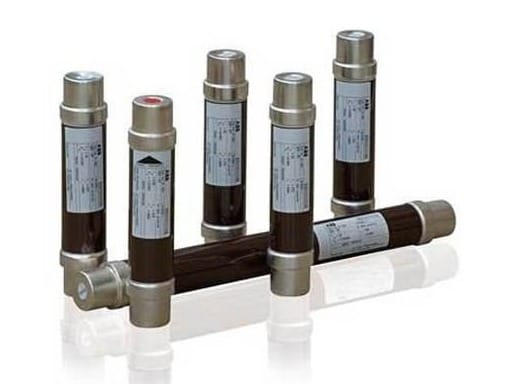Fuse
An electrical fuse is a simple device used to interrupt an electrical circuit during over current
condition due to short circuit and/or overload. An electrical fuse operates on the principle of heating
effect of electric current. During normal operating condition, the current flowing through the fusing
element is such that the rate of heat production in the fuse element is nearly equal to the rate of heat
dissipation from the fuse element and thereby they are will be no considerable increase of temperature of
that fuse element.
Table of Contents
Working Principle Of Fuse
The working principle of a fuse is based on thermal protection and overcurrent protection in electrical circuits
- Material: The fuse is made of a low-melting-point metal or alloy (e.g., tin, lead, zinc, or copper).
- Heating Effect of Current: When excessive current flows, the fuse wire heats up due to its resistance (Joule’s Law: H=I2RtH=I2Rt).
- Melting and Breaking: If the current exceeds the fuse’s rated value, the wire melts, breaking the circuit and stopping current flow Fuse
Fuse Symbol

Materials Used For electric Fuse Element
The main properties of a fuse element are
- They must have low melting point.
- They must have low ohmic loss.
- They must have low resistivity.
- They must be free from deterioration.
- They must be of moderate cost.
The metals like tin, lead and zinc are having all the above mentioned properties hence used widely as fuse
element. Although silver has very high cost but still it is used as fuse element where cost is not the main
criteria of application.
Current rating of fuse element
It is the current which the fuse element can carry without overheating or melting. It depends on
the temperature rise in the contacts of the fuse holder, fuse material and the surrounding of the fuse.
Fuse Current
It is the minimum current at which the fuse element begins to melt. Its value will be higher than the
Current rating of the fuse element.
For a round wire, the approximate relationship between the fuse currents I and the diameter d of the
The wire is given by
I = kd3/2
K is a constant called the fuse contact. The value of k depends on the material used to make the fuse
element.
The value of k for various elements, as found by Sir William Henry Preece, is given below
Value of k for different elements

The fusing current depends on various factors such as
Material of the fuse element
Length: smaller the length greater the current because a short fuse can conduct away all the heat
Diameter
Size and location of the terminals
Previous history
Type of enclosure used
Fusing factor
It is the ratio of the fusing current to the current rating of the fuse element.
Fusing Factor = Fuse current/Current rating of fuse
The value of the fusion factor is always greater than
1. The smaller the value of the fusing factor, the greater the chance of deterioration of the fusing element due to overheating and oxidation. For a semi-enclosed or rewirable fuse that employs copper as the fuse element, the value of the fuse factor is usually
2. Lower values of the fusing factor can be employed for an enclosed-type cartridge fuse that uses silver or bimetallic elements.

Prospective Current
the fault current would normally have a large first loop but it generate sufficient energy to
melt the fuse element before the peak value of the first loop is reached. The rms value of the first loop of
fault current is known as prospective current. Prospective current is defined as the rms value of first loop
of fault current is the fuse is replaced by an ordinary conductor of negligible resistance.
Cut-Off Current
It is the maximum value of fault current reached when the fuse melts. The current corresponds to the
Point ‘a is called the cut-off current. The cut-off value depends on
Current rating of the fuse
Value of prospective current
Asymmetry of the fault current
Pre-arcing Time
It is the time between commencement of the fault current and the instant when cut-off occurs. When a
fault occurs, the fault current rises rapidly and as the fault current reaches a cut-off value the fuse melts
and an arc is initiated. The time between the occurrence of the fault and the instant the arc is initiated is
called the pre-arcing time. The value of pre-arcing time is generally small and a typical value is 0.001
second.
Total Operating Time
The sum of pre-arcing and arcing times is called the total operating time. It may be noted that the operating
time of a fuse (0.002 seconds) is much lower than that of a circuit breaker (0.2 seconds). A fuse in series
with a circuit breaker of low breaking capacity is a useful and economical way of providing adequate short-circuit protection. In that case, the fuse will blow fast even before the circuit breaker begins to operate.
Breaking Capacity
It is the rms value of the AC component of maximum prospective current that a fuse can deal with at a
rated service voltage.
Types of Fuses
Since its invention, a lot of improvements have been made and now a variety of fuses are available. Some
fuses even have arrangements to extinguish the arc that appears when the fuel element melts. Fuses are
generally classified into two:
Low-voltage fuses
High-voltage fuses
Low Voltage Fuses
Low Voltage Fuses are of two types
Semi Enclosed Rewirable Fuse
High Rupturing Capacity (HRC) Cartridge Fuses
Semi Enclosed Rewirable Fuse
Rewirable fuses also known as kit-kat type fuses are used to interrupt fault currents of lower magnitude. It
consists of two parts: a base and a fuse carrier. The base is made of porcelain and carrier the fixed
contacts to which the incoming and outgoing phase wires are connected. The fuse carrier is also made of
porcelain and fuse elements between the terminals. The fuse carrier can be inserted or removed at any
time.

When a fault occurs the fuse element is blown out and the circuit is interrupted. The fuse carrier can be
taken out and the blown out fuse element can be replaced by a new one. It is then inserted to the base to
restore the supply.
Advantages:
Detachable fuse carrier permits the replacement of fuse element without coming in contact with
live parts.
Cost of replacement is negligible.
Disadvantages:
The possibility of renewal with fuse wire of the wrong size and improper material.
Low breaking capacity, so it cannot be used in circuits with higher fault current levels.
The fuse element is subjected to deterioration by oxidation through the continuous heating up of
the element. This reduces the current rating of the fuse. Thus the fuse operates at a current lower
than the rated value.
Uncertainty in the protective capacity of the fuse since it is affected by ambient conditions.
Accurate calibration of the fuse is not possible as the fusing current depends on the length of the
fusing element.
Semi enclosed rewirable fuses have capacity up to 500A but their breaking capacity is much lower so
their use is limited to domestic and lighting applications only.
High Rupturing Capacity (HRC) Cartridge Fuse
The shortcomings of uncertain and low breaking capacity of semi enclosed rewirable fuse are overcome
in HRC cartridge fuse. It consist of a heat resisting ceramic body with metal end caps to which is welded
silver current carrying element. The space surrounding the element is completely packed with a filling
powder. The filling powder can be of chalk, plaster of Paris, quartz or marble dust and act as an arc
quenching and cooling medium.

The HRC cartridge fuse carried the normal current without overheating. During the occurrence of a fault,
the current increases and the fuse element melts before the fault current reaches its first peak. The heat
produced in the process vaporises the melted silver element. The chemical reaction between the silver
vapours and the filling powder results in a high-resistance substance that helps in quenching the arc

Advantages
Capable of clearing high as well as low fault currents
Does not deteriorate with age
High speed of operation
Provide reliable discrimination
Require no maintenance
Cheaper than other circuit interrupting devices of equal breaking capacity
Disadvantages
Must be replaced after operation
Heat produced by the arc may affect the associated switches
High Rupturing Capacity Fuse with Tripping device
In some case, the HRC fuse is provided with a tripping device. During the occurrence of a fault the fuse
is blown out and the tripping device causes the circuit breaker to operate. The body of the fuse is made of
a ceramic material with a metal cap attached rigidly to both ends. The caps are connected by a number of
silver fuse elements. At one end of the fuse there is a plunger. Under fault condition it hits the tripping
mechanism of the circuit breaker and causes it to operate. The plunger is electrically connected by means
of a fusible link, chemical charge and a tungsten wire to the other end of the cap.

When fault occurs, the silver fuse elements are the first to be blown out and the current is then transferred
to the tungsten wire. The weak link in series with the tungsten wire gets fused and causes the chemical
charge to be detonated. This forces the plunger to move outward to operate the circuit breaker. The travel
of the plunger is so set that it is not ejected from the fuse body under the fault conditions.
Advantages over the fuse without triggering device
In case of a single phase fault on a three phase system, the plunger operates the tripping
mechanism of circuit breaker to open all the three phase and thus prevents ‘single phasing’
The effect of full short circuiting need not be considered in the choice of circuit breaker. This
prevents from the use of expensive circuit breakers
The fuse tripped circuit breaker is generally capable of dealing with fairly small fault current
itself. This avoids the necessity for replacing the fuse except after highest currents fir which it is
intended
High Voltage fuses
Due to the fact that the low voltage fuses has low current rating and breaking capacity they cannot be
used for modern high voltage systems. With the advancement in technology researches found a way to
protect the high voltage circuits; the high voltage fuses.

Conclusion
A fuse works by sacrificing itself to protect the circuit. When excessive current flows, the fuse element melts, opening the circuit and preventing damage. It is a passive but critical component in electrical safety systems.
what is Heating Effect?
As electric current flows through a conductor, resistance opposes its flow, thereby producing heat. The conversion of electrical energy into heat energy is called Joule heating
what is Magnetic Effect?
During the flow of electric current in a conductor a magnetic field is produced perpendicular to the direction of current flow.
Uses- in electric bells, motors and generators etc.what is Chemical Effect?
When electric current is passed through an electrolyte (copper sulphate solution) both the electrons and the positive ions of copper carry out the flow of electric current.
